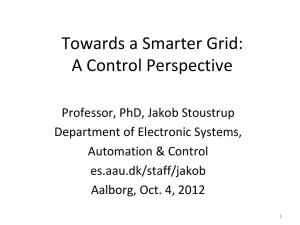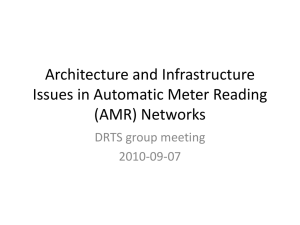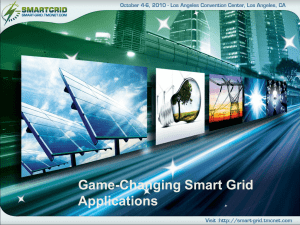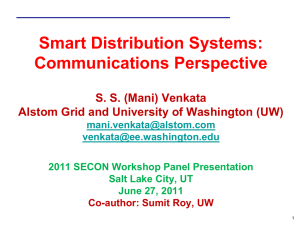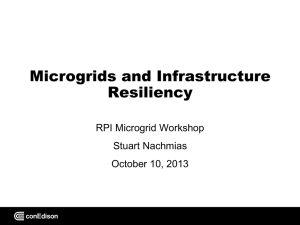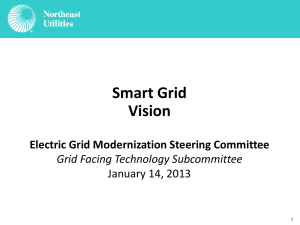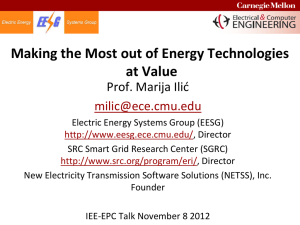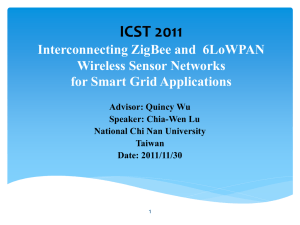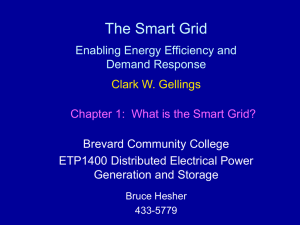Demand Response - BBCR Group
advertisement
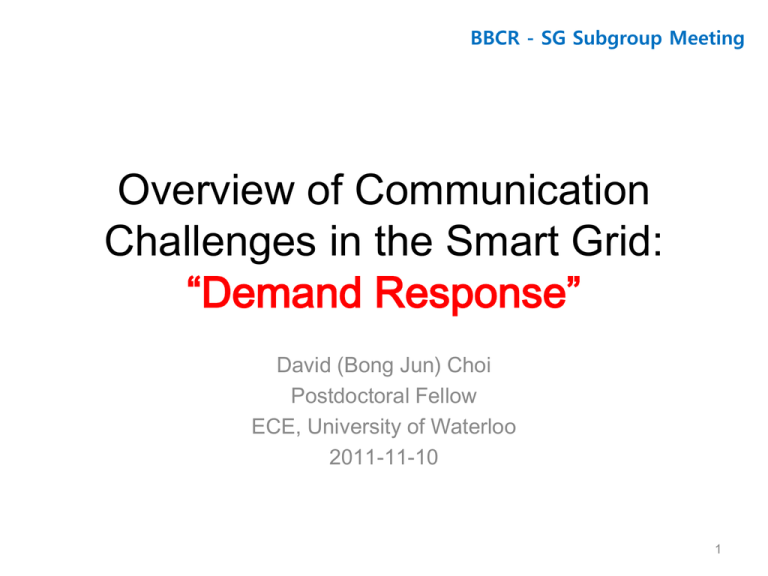
BBCR - SG Subgroup Meeting Overview of Communication Challenges in the Smart Grid: “Demand Response” David (Bong Jun) Choi Postdoctoral Fellow ECE, University of Waterloo 2011-11-10 1 Table of Contents • Overview of Demand and Response in SG – Demand and Supply? • Literature Review: “IEEE Networks: Communication Infrastructure for SG” ① “Challenges in Demand Load Control for the Smart Grid” ② “Knowing When to Act: An Optimal Stopping Method for Smart Grid Demand Response” 2 Overview • Electricity Demand – Large variations – Some patterns a) Individual Household b) Ontario Aggregated 3 Overview • Electricity Supply – “Non-renewable” (Nuclear, Fuel, etc.) • Environmental problem, fuel cost – “Renewable” (Hydro, Wind, Solar, Tidal, etc.) • Intermittent, low reliability, deployment cost a) Ontario Power Generation by Type 4 System Architecture 5 Overview • Demand Response – Goal • Electricity Demand = Electricity Supply – Basic Methodology • Transfer: non-emergent power demand from onpeak to off-peak • Store: energy during off-peak and use during onpeak • Induce/encourage: customers to use energy during off peak 6 Overview • Energy Pricing – Tiered (KWh/month threshold) • Lower-tier: inexpensive • Higher-tier: expensive – Time-of-Use (TOU) – By Contract – Market Price a) TOU Pricing in Ontario • Fluctuating price + fixed price (global adjustment) b) Real-Time Pricing in Ontario 7 Overview • Expected Gain – Supplier (Utilities) • Lower operation cost (a.k.a. “peak shaving”) – Consumer (Customers) • Lower real-time electricity price • Due to being aware of quick real-time pricing and response 8 Current Development • Demand Task Scheduling – Satisfy future power demand request within some bound • Various threshold based schemes • Load shifting to off-peak periods by consumers [5] M. J. Neely, A. Saber Tehrani, and A.G. Dimakis, “Efficient Algorithms forRenewable Energy Allocation to Delay Tolerant Consumers,” Proc. IEEE Int’l. Conf. Smart Grid Commun., 2010. [6] I. Koutsopoulos and L. Tassiulas, “Control and Optimization Meet the Smart Power Grid: Scheduling of Power Demands for Optimal Energy Management,” Proc. Int’l. Conf. Energy Efficient Computing and Networking, 2011. [7] A.-H. Mohsenian-Rad and A. Leon-Garcia, “Optimal Residential Load Control with Price Prediction in Real-time Electricity Pricing Environments,” IEEE Trans. Smart Grid, vol. 1, no. 2, Sept. 2010, pp. 120–33. 9 Current Development • Use of Stored Energy – Store at off-peak + Use at on-peak • Online algorithms • Considering PHEVs [8] R. Urgaonkar et al., “Optimal Power Cost Management using Stored Energy in Data Centers,” Proc. SIGMETRICS, 2011. [9] M. C. Caramanis and J. Foster “Management of Electric Vehicle Charging to Mitigate Renewable Generation Intermittency and Distribution Network Congestion,” Proc. 48th IEEE Conf. Dec. Control, 2009. 10 Current Development • Real-Time Pricing – Encourage consumers to shift their power demand to off-peak periods • Incentive based algorithms • Group based algorithms [10] A.-H. Mohsenian-Rad et al., “Optimal and Autonomous Incentive-based Energy Consumption Scheduling Algorithm for Smart Grid,” Proc. IEEE PES Conf. Innovative Smart Grid Tech., 2009. [11] L. Chen et al., “Two Market Models for Demand Response in Power Networks,” Proc. IEEE Int’l. Conf. Smart Grid Commun., 2010. 11 Research Challenges • Energy Storage+ – Battery management • Communication – Which technology to use? • Distributed Generation+ – Fixed (not so adaptive) electricity supply – Diversifying power generation options (i.e., distributed power generation) • Vehicle to Grid Systems (V2G)+ – Incorporation of PHEVs 12 Literature Review 1: “Challenges in Demand Load Control for the Smart Grid” Iordanis Koutsopoulos and Leandros Tassiulas, University of Thessaly and Center for Research and Technology Hellas 13 Overview • Observation – Cost of power increases as demand load increases • Solution – Online scheduling, – Threshold-based policy that (1) activate demand when the demand is low or (2) postpone demand when the demand is high • Battery for demand shading – i.e., Increase off-peak demand load, decrease onpeak demand load 14 Online Dynamic Demand Scheduling • Goal: Minimize long run average cost – Steady state • exponential dist. (request arrival, deadline) – P(t): total instantaneous consumed power in the grid – d: deadline by which request to be activated 15 Online Dynamic Demand Scheduling • No Control: – Activate upon demand request • Threshold-based Control Policies 1. Binary Control • threshold value P • If P(t) < P, activate • Otherwise, postpone activation to the deadline 2. Controlled Release • “Binary Control” + activate if deadline or P(t) < P • More flexible scheduling 16 Performance Evaluation 17 Literature Review 2: “Knowing When to Act: An Optimal Stopping Method for Smart Grid Demand Response” Abiodun Iwayemi, Peizhong Yi, Xihua Dong, and Chi Zhou, Illinois Institute of Technology 18 Overview • Motivation – Real time pricing – Operate electrical appliances when the energy price is low – Tradeoff • Energy Saving vs. Delaying Device Usage • Goal – Home automation – “Decide when to start appliances” • Solution Approach – Optimal Stopping Approach to optimize the tradeoff 19 System Model • Home Area Networks – Smart appliances (computing, sensing, communication) • Reduce energy cost – Home Energy Controller (HEC) • Advanced Metering Infrastructure (AMI) – Bidirectional – Wireless Technology • GPRS, Wi-Fi, Mesh network • Neighbor Area Network 20 Solution Approach • “Marriage Problem” (Secretary Problem) – 100 brides – Interview in random order and take score – Choose one bride from interviewed brides • Solution – interview 37 (=100/e) and then select one – Prob(select best choice) = 0.37 • Extended to scheduling appliances 21 Problem Formulation • OSR (Optimal Stopping Rule) – Objective: min cost – Constraints: energy allocation, capacity limit Full details: [14] P. Yi, X. Dong, and C. Zhou, “Optimal Energy Management for Smart Grid Systems An Optimal Stopping Rule Approach,” accepted for publication at the IFAC World Congress Invited Session on Smart Grids-2011. 22 Thanks!!! DISCUSSION / QUESTION 23

